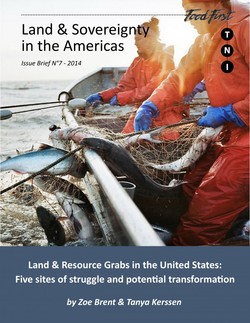Land & resource grabs in the United States: Five sites of struggle and potential transformation
October 2014, Land & Sovereignty Brief No. 7
Across the United States, communities are fighting to defend the resources they need to produce food. Corporate control of the food system is undermining the livelihoods of family farmers, farmworkers, fisherpeople, communities of color, and indigenous peoples—squeezing them economically; contaminating their soils and waterways; and pushing them off the land. These processes of dispossession and disenfranchisement— dubbed a new wave of global “land grabbing”—are not new, nor are they confined to poor countries of the Global South. Indeed, they form the basis of the history of capitalist expansion in the US. What is new, perhaps, is the rapid rate at which land and other resources are being concentrated in the hands of new financial and institutional actors—thanks to policies that favor profits over people, and finance over food.
In the face of such momentous challenges, the capacity of local, regional, and community-based movements to create systemic change depends on their ability to link their respective struggles while at the same time confronting and resolving the historical, cultural, and strategic differences among them. While these differences are many, a number of crosscutting issues can be identified that help us to make sense of 1) the rapid transformations underway in our nation’s land and resource base, and 2) the ways in which communities have organized themselves to confront these threats. While numerous issues intersect with the question of land, here we identify five strategic “nexuses” to help us understand how land converges with historically embedded power relations in the United States:
- The Land-Labor Nexus
- The Land-Race Nexus
- The Land-Finance Nexus
- The Land-Water Nexus
- The Land-Climate Nexus
While each nexus represents an area of capital expansion, growing crisis, and deepening inequality, it also embodies a key site of intensifying resistance and potential for systemic change.
Click here to download the full brief.
This is the seventh brief in the Land & Sovereignty in the Americas series, co-published by Food First and the Transnational Institute.
About the series:
The Land & Sovereignty in the Americas series pulls together research and analysis from activists and scholars working to understand and halt the alarming trend in “land grabbing”—from rural Brazil and Central America to US cities like Oakland and Detroit—and to support rural and urban communities in their efforts to protect their lands as the basis for self-determination, food justice and food sovereignty. The series—which includes short issue briefs and books—is a project of the Land & Sovereignty in the Americas (LSA) activist-researcher collective, coordinated by Food First. For media inquiries about this series, or to arrange an interview with an author, please contact [email protected].
About the authors:
Zoe Brent is a Food First Fellow, Coordinator of the Land and Sovereignty in the Americas Collective, and a PhD student at the Institute of Social Studies in The Hague, Netherlands; Tanya Kerssen is the Research Coordinator at Food First and author of the book Grabbing Power: The new struggles for land, food and democracy in Northern Honduras.
L&S No. 7 Land and Resource Grabs in the United States – Brent and Kerssen 2014














